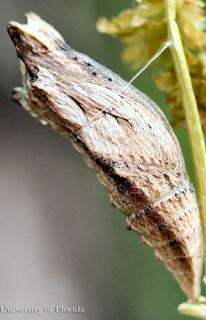Posted by: Jessica Wong, PhD Student, CSU Department of Bioagricultural Sciences
and Pest Management
Insects
have remarkable strategies for surviving Colorado winters. A few species
migrate to escape the cold. The most well-known species to do this is of course
the monarch butterfly. By now they have made their way to roosting sites in
Mexico (or California in the case of monarchs from the Western Slope). The
green darner, Colorado’s largest dragonfly, is another species that makes its way south
before winter arrives. For
the rest of the insects that can’t fly thousands of miles, they stay put right
here in Colorado.
Most insects have figured out how to survive our cold,
dry, snowy, sometimes balmy winters. A few, like brown marmorated stink bugs and multicolored Asian lady beetles, will escape the
cold by going indoors. Cracks and gaps in door and window frames are
great opportunities for them, so make sure those are well sealed to prevent
them from invading your house. The rest of the insects stay outdoors and go
dormant. These insects produce their own antifreeze compounds to withstand temperatures
well below 32 degrees. And they have genetic programming that prevent them from
coming out of dormancy too early, which is handy on that 70 degree day in
February.
 |
| Multicolored
Asian lady beetles preparing to overwinter. Photo by Howard Russell &
Christine DiFonzo, Michigan State University |
Insects overwinter in different life stages – egg, larva,
pupa, or adult – depending on species. Most species of aphids and crickets
survive the winter as eggs. Aphid eggs can be found on trees and shrubs, and
cricket eggs can be found in the soil. Japanese beetle and emerald ash borer are two serious pests that overwinter as larvae (also known as
grubs). Japanese beetle grubs spend the winter in the soil under turfgrass,
such as your lawn. Emerald ash borers overwinter in their galleries just under
the bark of ash trees.
 |
Japanese
beetle larvae. Photo by David Shetlar, the Ohio State University
|
 |
| Emerald
ash borer larva in its gallery. Photo by Howard
Russell, Michigan state University |
Black swallowtail butterflies survive the winter in their
pupal (chrysalis) form, while another butterfly species, the mourning cloak,
overwinters as adults. Bumblebees and yellowjackets also overwinter in the
adult stage. Both bumblebees and yellowjackets are social insects with colonies
in the spring and summer, but in the fall workers start to die and only
fertilized queens survive through the winter. When spring finally comes all the
insects break dormancy and resume their unique life cycles.
 |
| Black
swallowtail pupa. Photo by Donald Hall, University of Florida |







Thanks for sharing
ReplyDeleteOne of my favorite books is “Life in the Cold” by Peter Marchand. Many insects concentrate alcohol or salt in their blood to survive the winter. I’ve gone into a cabin at 20 below, and as soon as we got a fire going, the cabin was full of flies.
ReplyDelete